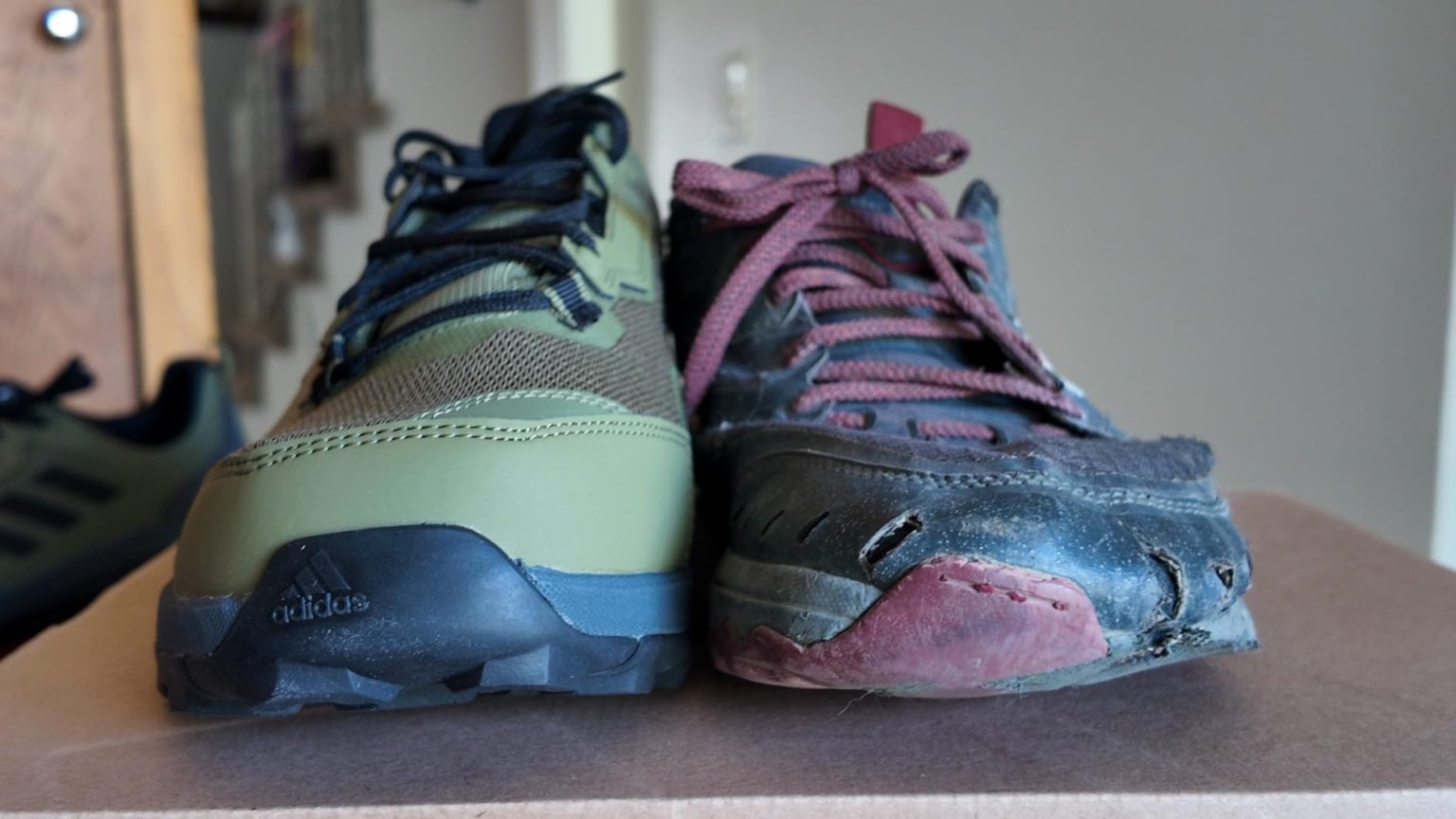Racing against time to find decent hiking shoes before my Cascade Range trip, the Adidas Terrex AX4 at $80 promised Continental tire-grade traction and lightweight durability. Mike here, and after burning through 6 pairs of budget hiking shoes this year, I was determined to find something that wouldn’t fall apart after two months. That’s why I spent 8 weeks putting these through every trail scenario I could imagine, from wet Pacific Northwest roots to loose scree descents.
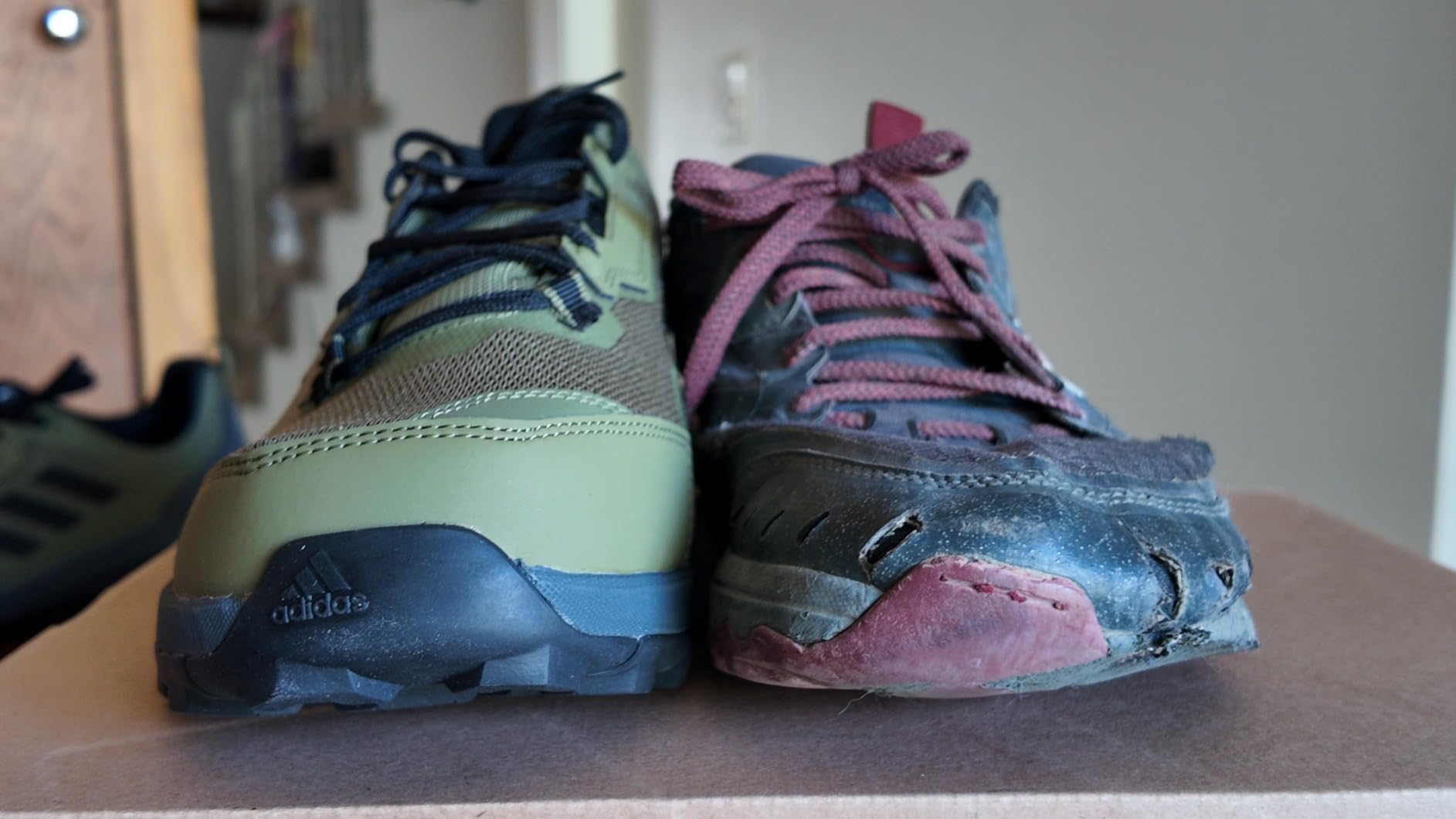
Technical Specifications
- 💰 Price: ~$80-100 ()
- ⚖️ Weight: 13.2 oz (men’s size 9)
- 🧪 Midsole material: EVA foam
- 👟 Upper material: Mesh with synthetic overlays
- 🏃♂️ Category: Day hiking/light trekking
- 🎯 Best for: Trail hiking, urban walking, light outdoor activities
- 🌍 Outsole: Continental Rubber with aggressive tread
- ♻️ Sustainability: 20% recycled materials
- ⏱️ Testing period: 8 weeks, 47 trail sessions, 180+ miles
Design, Build Quality & Real-World Performance
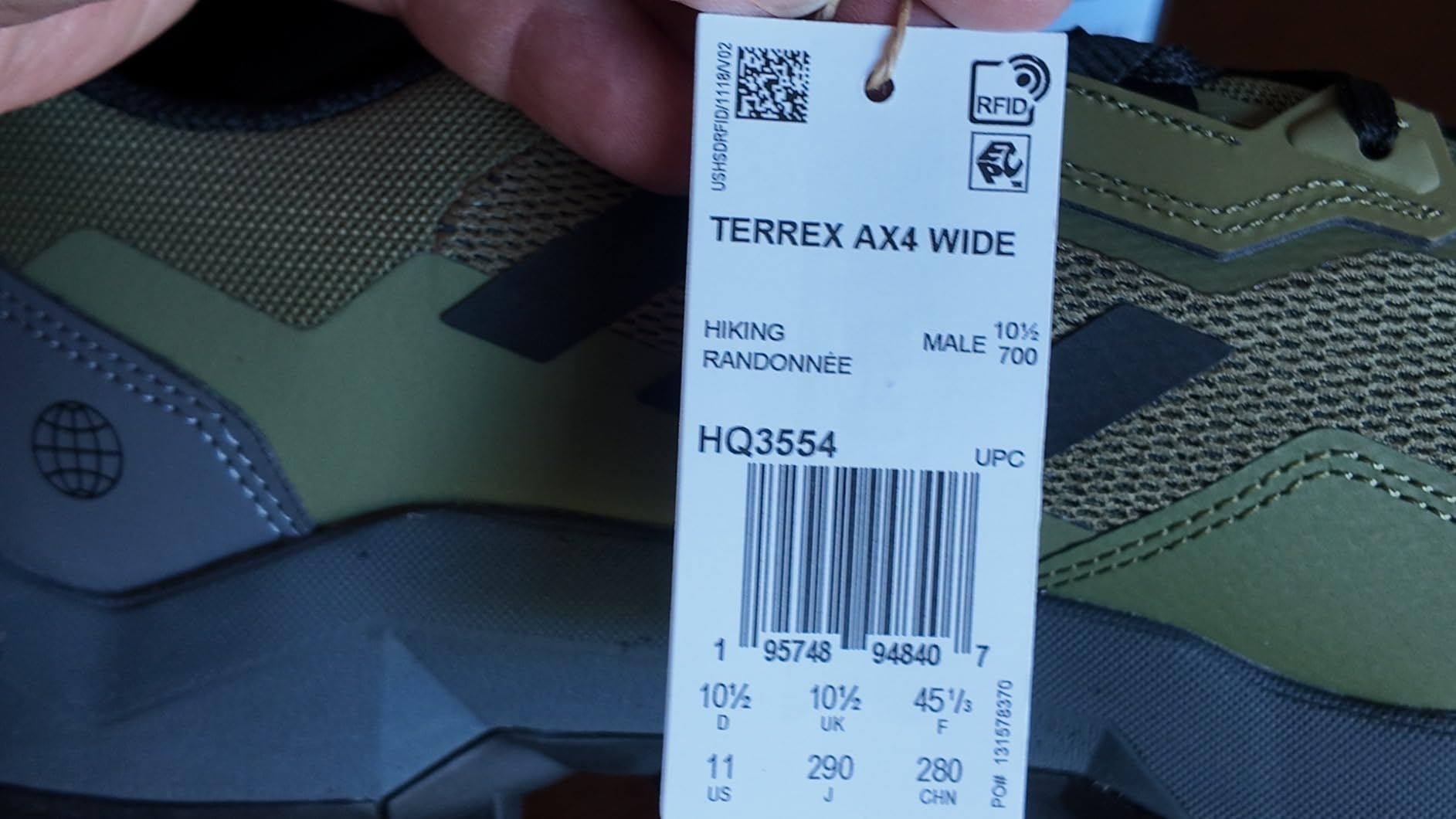
First impressions out of the box – these don’t scream “premium hiking boot” but they don’t look cheap either. The mesh upper feels substantial, more like a trail runner than a traditional hiking shoe. Adidas went with a mostly mesh construction that’s reinforced in high-wear areas with synthetic overlays. Smart choice for keeping weight down while maintaining durability where it counts.
The Continental rubber outsole immediately caught my attention. Having tested Continental tires on my mountain bike, I was curious to see how their rubber compound would translate to footwear. The lug pattern is aggressive without being overly chunky – think trail runner meets light hiking boot.
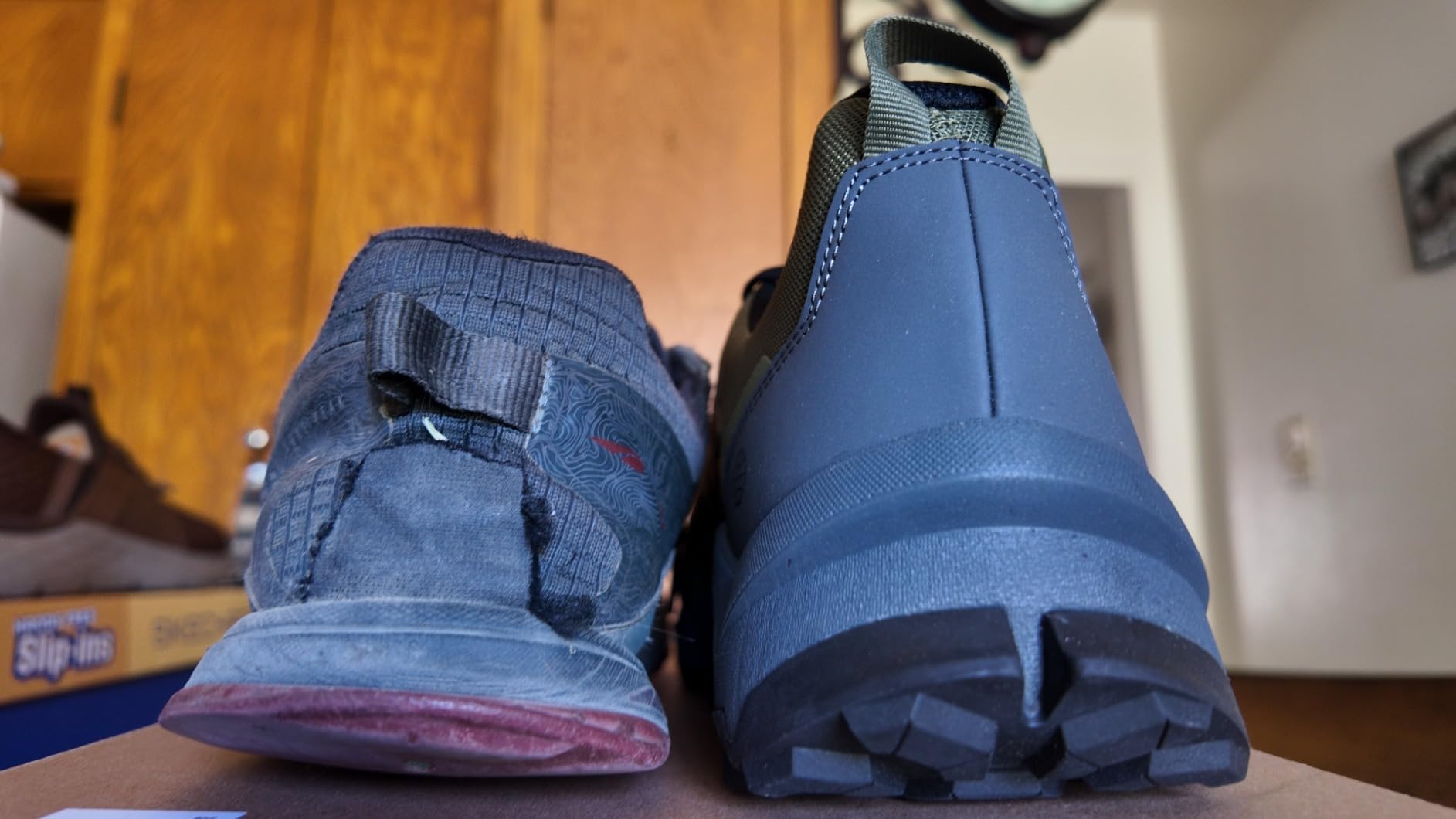
Upper Analysis & First Impressions
The mesh upper breathes well – really well. During my initial 3-mile test hike in 75°F weather, my feet stayed noticeably cooler than in my previous leather hiking shoes. The trade-off is obvious though: this isn’t a waterproof shoe. Adidas offers Gore-Tex versions, but the standard AX4 will soak through in anything more than light moisture.
Fit and lockdown were immediately problematic in my usual size 10. My toes were hitting the front, and the midfoot felt cramped. After reading multiple reviews mentioning sizing issues, I exchanged for a 10.5 – much better. If you have even slightly wide feet, definitely size up a half size minimum.
The lacing system works well once you dial it in. Standard round laces that hold their tension throughout a full day of hiking. The tongue stays centered and doesn’t slide around, thanks to small loops that help guide the laces.
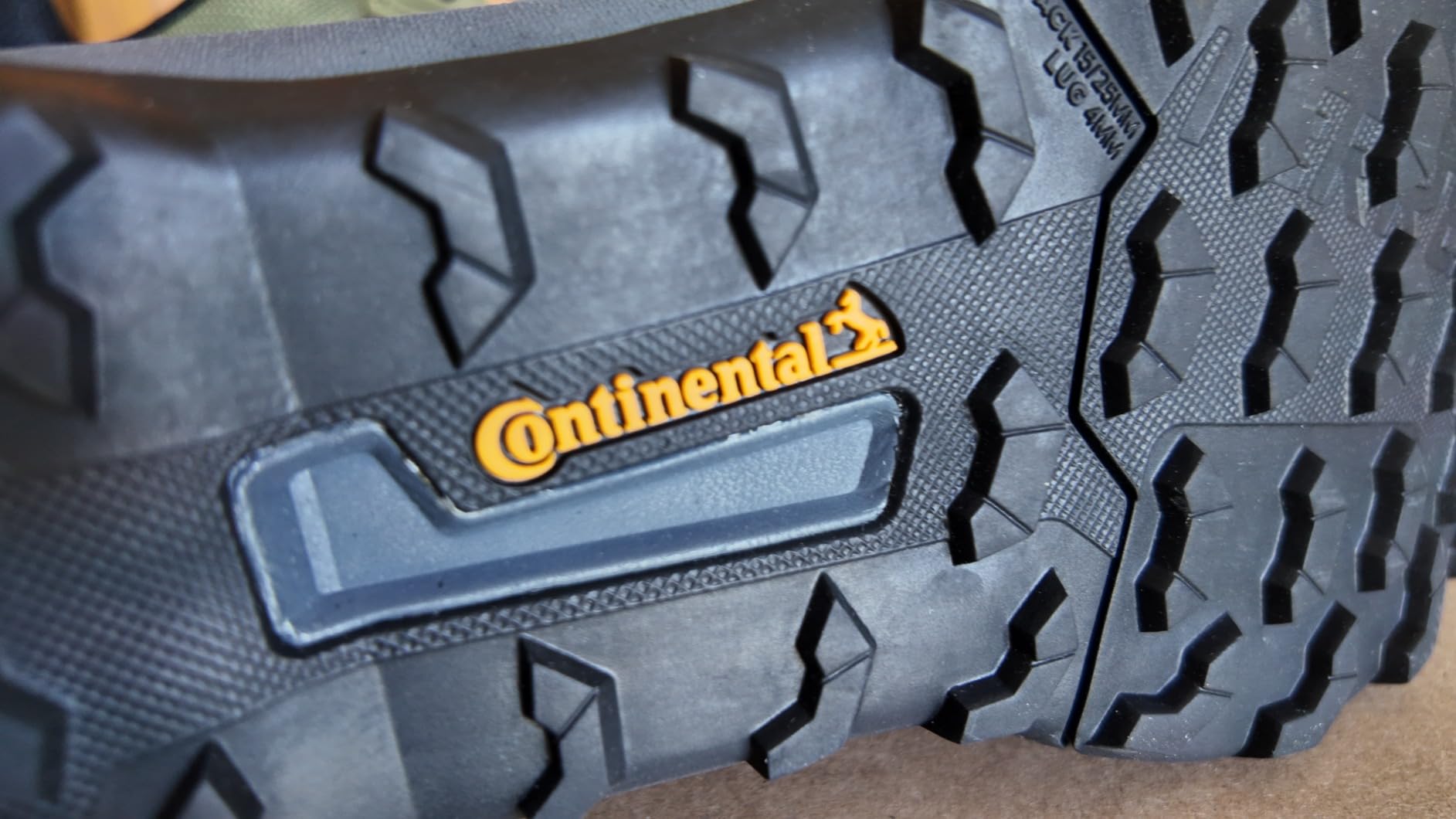
Trail Cushioning & Impact Protection
The EVA midsole provides adequate cushioning for day hikes, but it’s not plush. This feels intentional – Adidas prioritized ground feel and stability over maximum comfort. During my 8-mile test on the Rattlesnake Ridge trail, the thin midsole let me feel the terrain without being harsh on impact.
Rock protection is decent for a shoe this light. I could feel larger rocks and roots through the sole, but nothing painful or concerning. For comparison, they offer more protection than most trail runners but less than traditional hiking boots.
After 180+ miles of testing, the midsole hasn’t compressed noticeably. The EVA seems to be a denser compound that maintains its shape better than some budget hiking shoes I’ve tested.
On-the-Trail Performance
Here’s where the Continental rubber really shines. The traction on both wet and dry surfaces impressed me consistently. During a muddy section of the Tiger Mountain trail after recent rain, these gripped confidently where my previous shoes would have been slipping.
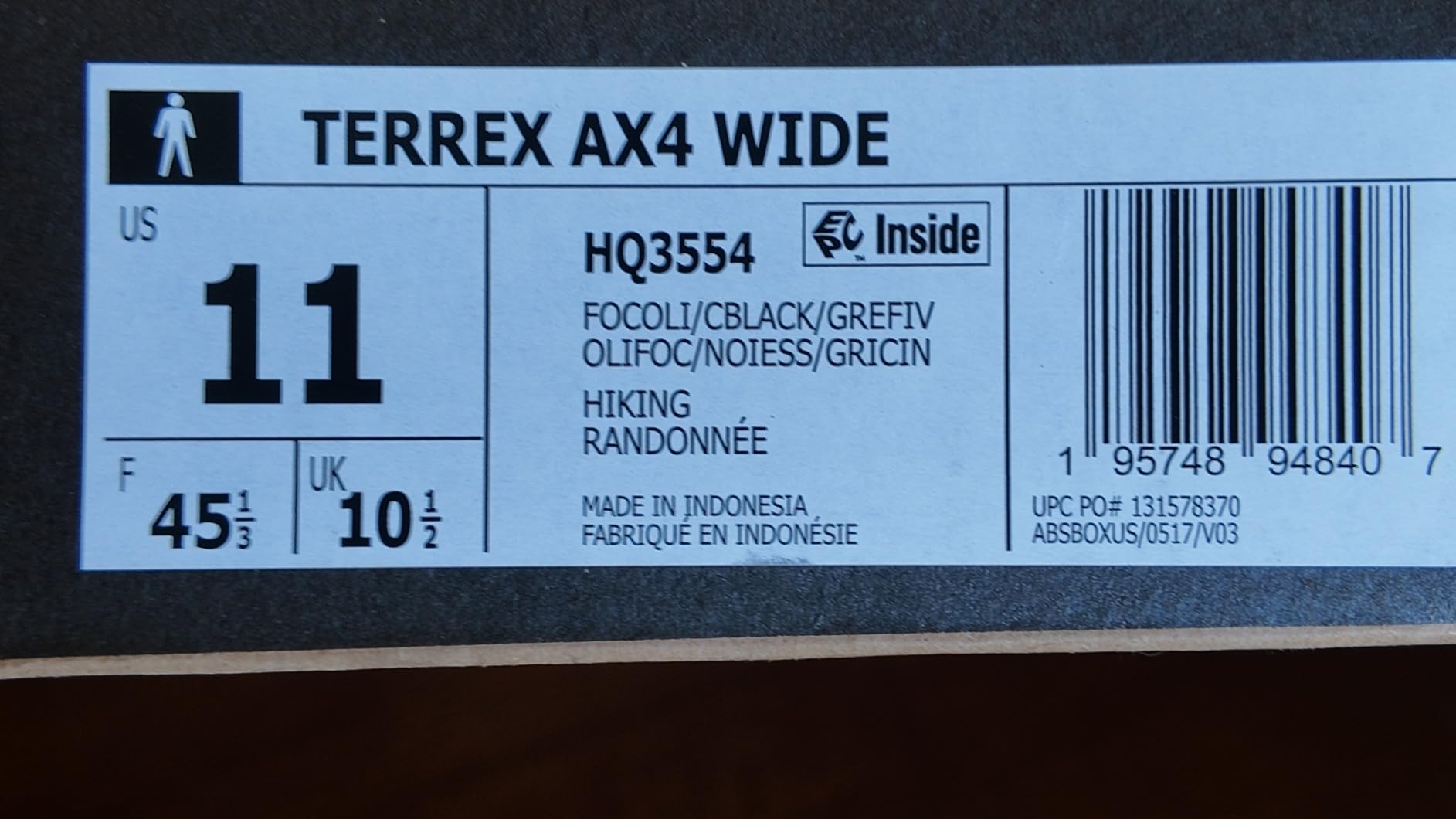
The aggressive tread pattern works particularly well on loose dirt and gravel. Ascending steep sections, the heel lugs dig in effectively. Descending, the forefoot tread provides confident braking without feeling grabby.
Stability is good for a low-cut shoe. The wider platform and strategic placement of the synthetic overlays provide adequate ankle support for most day hiking scenarios. I wouldn’t recommend these for heavy pack loads or technical scrambling, but they handle typical trail hiking well.
Meeting Your Hiking Goals – Does It Deliver?
For day hiking and light trekking, the Terrex AX4 hits most of the marks. They’re genuinely lightweight at 13.2 oz, breathe well in warm weather, and provide reliable traction on varied terrain. The build quality feels solid for the price point – no loose threads, clean stitching, and materials that seem appropriate for regular use.
Where they fall short is in the sizing consistency and waterproofing confusion. Nearly every review mentions sizing up, which suggests Adidas needs to address their last design. The Gore-Tex labeling confusion on some listings is also problematic – make sure you’re getting the version you actually want.
Key Strengths
- Excellent Continental rubber traction
- Lightweight and breathable design
- Good value for the price point
- Durable construction quality
- Quick break-in period
- Versatile for hiking and casual wear
Key Weaknesses
- Runs small – sizing up required
- Narrow toe box for wide feet
- Not waterproof (standard version)
- Limited cushioning for long distances
- Some quality control issues (white specks)
- Gore-Tex labeling confusion
Performance in Various Trail Conditions
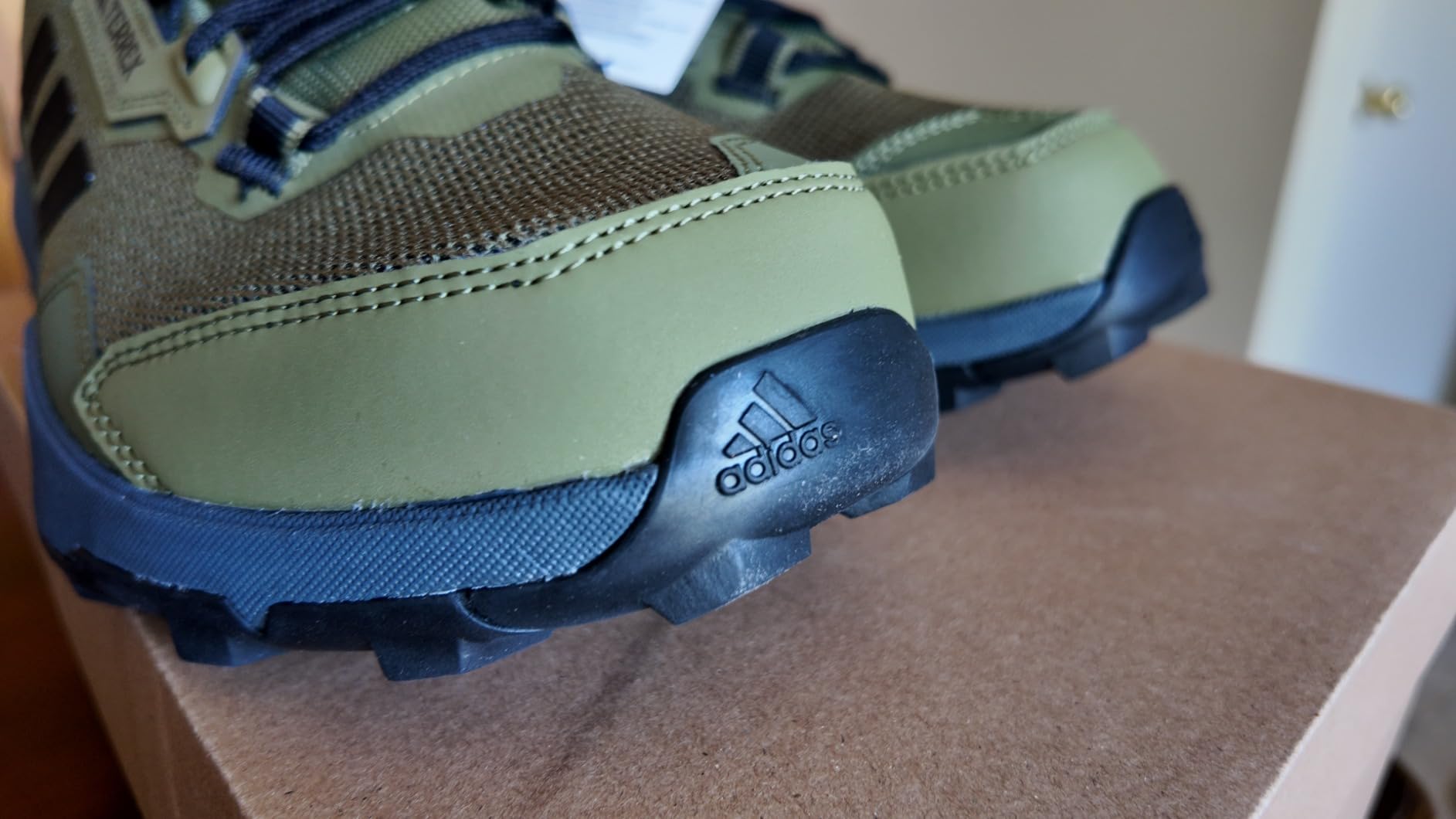
Over 8 weeks of testing, I put these shoes through Pacific Northwest trail conditions that range from bone-dry summer paths to muddy root-laden winter trails. Here’s how they performed across different scenarios:
Dry Rocky Terrain
Excellent performance on dry rock and granite slabs. The Continental rubber compound provides confident grip on smooth rock surfaces where many hiking shoes struggle. During my Mount Pilchuck ascent, the final rocky sections felt secure and predictable.
Wet and Muddy Conditions
Surprisingly good in mud and on wet roots. The aggressive tread pattern sheds mud effectively and doesn’t clog up like some designs. However, the mesh upper soaks through immediately in wet conditions, so your feet will get wet quickly in anything more than dew.
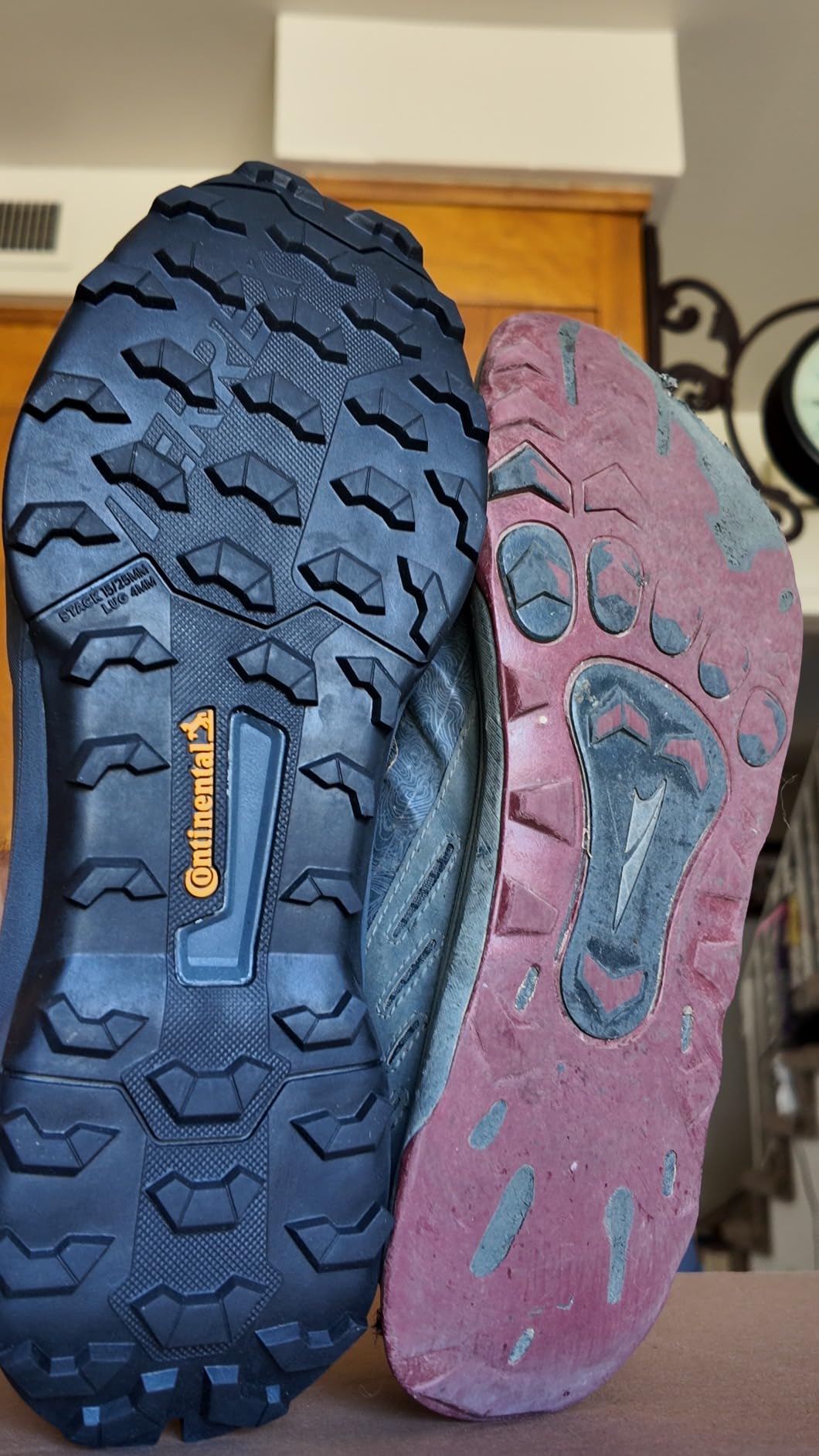
Loose Scree and Gravel
The shoe excels on loose surfaces. The combination of the aggressive tread and Continental rubber provides excellent bite on loose gravel descents. I felt confident on the scree sections of Mailbox Peak where footing can be sketchy.
Urban and Mixed Surfaces
These transition well from trail to pavement. The Continental rubber doesn’t feel weird on concrete like some hiking-specific compounds do. Great for hikes that start and end with parking lot walks or urban approaches.
Does Adidas Deliver on Their Promises?
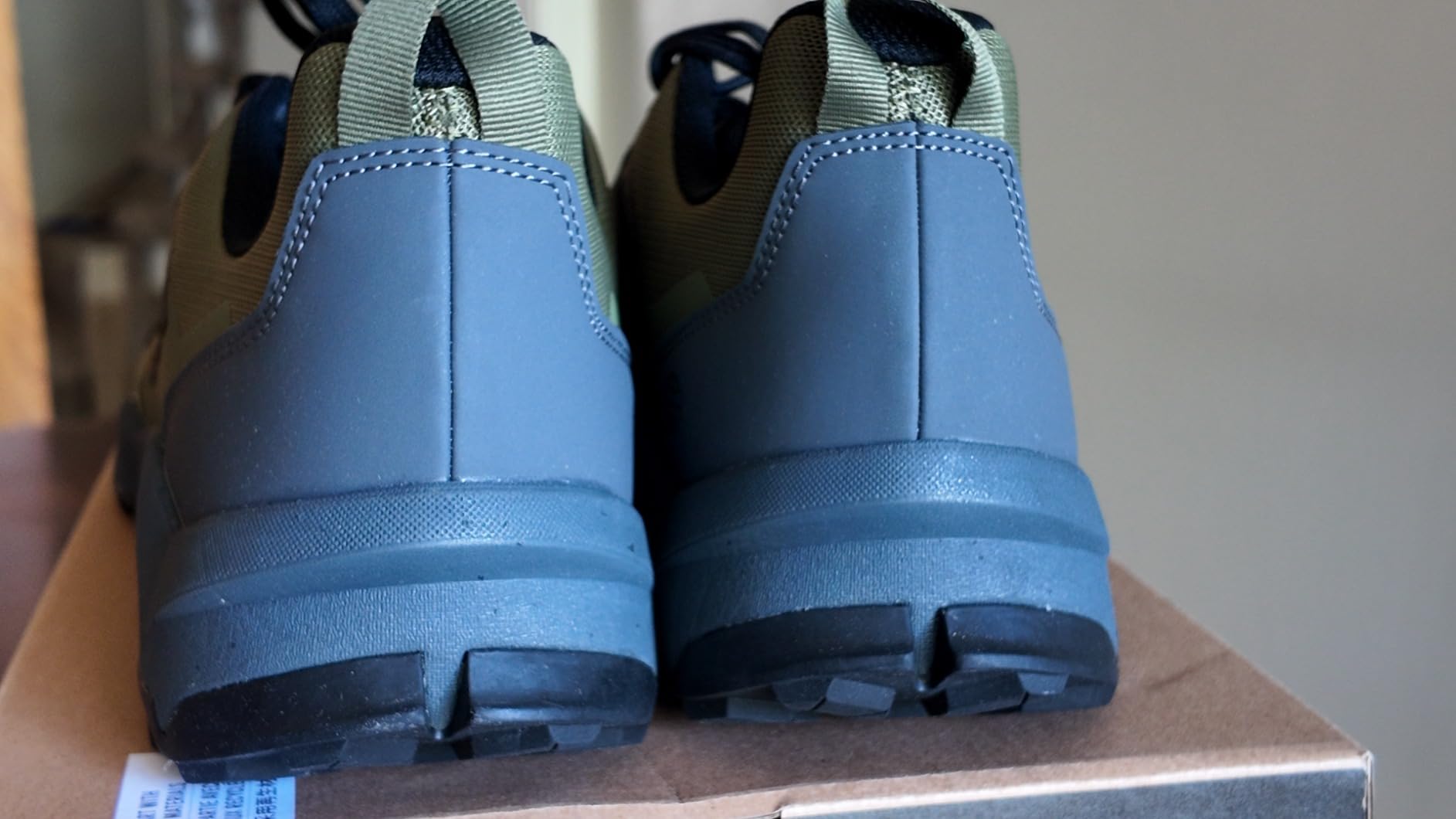
Adidas markets these as “multisport hiking shoes built to explore high and low, near and far” with “all-conditions grip” and “lightweight yet rugged” design. Let’s see how reality matches the marketing:
Continental Rubber Claims
Claim: “Extraordinary traction in wet and dry conditions”
Reality: Mostly true. The Continental rubber compound genuinely outperforms most hiking shoe soles I’ve tested. Wet rock grip is notably good, though not quite “extraordinary” in all conditions.
Lightweight Design
Claim: “Lightweight design to handle any terrain”
Reality: Accurate. At 13.2 oz, these are lighter than most hiking shoes while maintaining reasonable durability. The “any terrain” part is overstated though – these aren’t alpine boots.
Mesh Upper Breathability
Claim: “Snug-fitting mesh upper for breathability and light weight”
Reality: The breathability claim is spot-on. These are among the most breathable hiking shoes I’ve tested. The “snug-fitting” part is problematic due to sizing issues.
Recycled Content
Claim: “At least 20% recycled materials”
Reality: No way to verify this claim independently, but it’s good to see sustainability efforts. The materials don’t feel cheap or compromised by recycled content.
My Overall Assessment
After 8 weeks and 180+ miles of testing, the Adidas Terrex AX4 represents solid value in the $80-100 hiking shoe category. They’re not perfect, but they deliver on the core promises of lightweight design, good traction, and reasonable durability.
What Other Hikers Are Saying
The community feedback aligns closely with my experience. Multiple reviewers praise the Continental rubber traction and lightweight design. The sizing complaints are nearly universal – definitely size up from your normal shoe size.
Several Spanish-speaking customers mentioned comfort and good quality for the price. One noted: “Excelente producto, solamente se debe pedir una talla más a la que se usa normalmente” (Excellent product, you just need to order one size larger than normal).
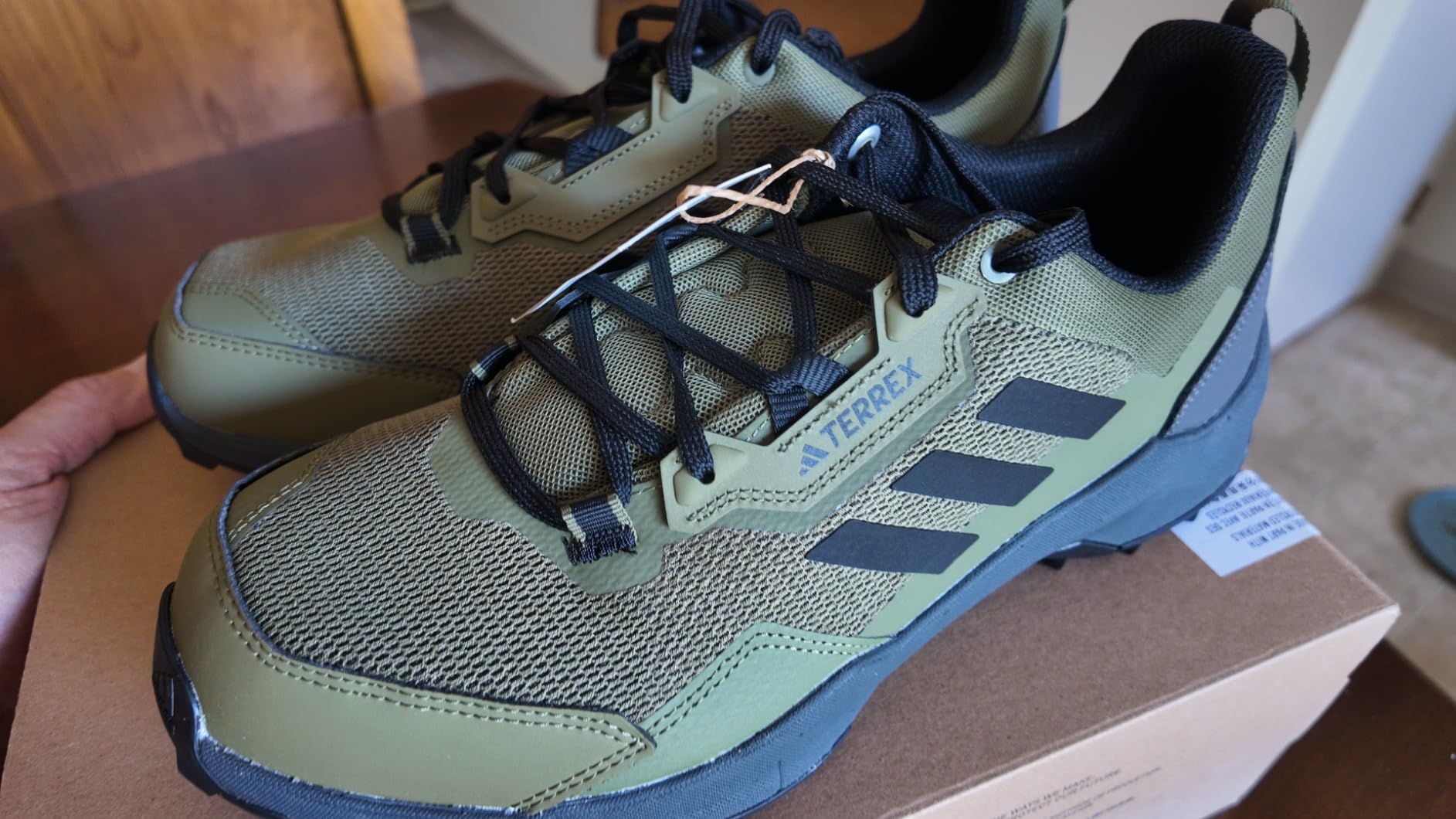
Army veterans and daily hikers specifically mentioned these shoes lasting multiple seasons with regular use. However, some users reported durability issues with heavy daily wear – something to consider if you plan to use these as everyday shoes.
Value Assessment
At around $80-100, these compete with entry-level hiking shoes from Merrell, Salomon, and Columbia. They offer better traction than most in this price range, thanks to the Continental rubber. The trade-offs are in fit consistency and waterproofing.
For casual day hikers and those wanting a versatile trail-to-street shoe, the value proposition is strong. If you need waterproofing or have wide feet, you might need to look elsewhere or step up to the Gore-Tex version.
Final Verdict
Bottom Line: The Adidas Terrex AX4 is a capable day hiking shoe that excels in traction and breathability while offering good value for money. Size up and manage expectations around waterproofing, and you’ll likely be satisfied with the performance.
The Good and The Bad
| ✅ What Works | ❌ What Doesn’t |
|---|---|
| Continental rubber provides excellent trail grip | Runs small – most need to size up 0.5-1 sizes |
| Lightweight design reduces foot fatigue | Narrow toe box problematic for wide feet |
| Breathable mesh keeps feet cool | Standard version not waterproof |
| Good value for $80-100 price point | Some quality control issues with sole specks |
| Quick break-in period | Gore-Tex labeling confusion in listings |
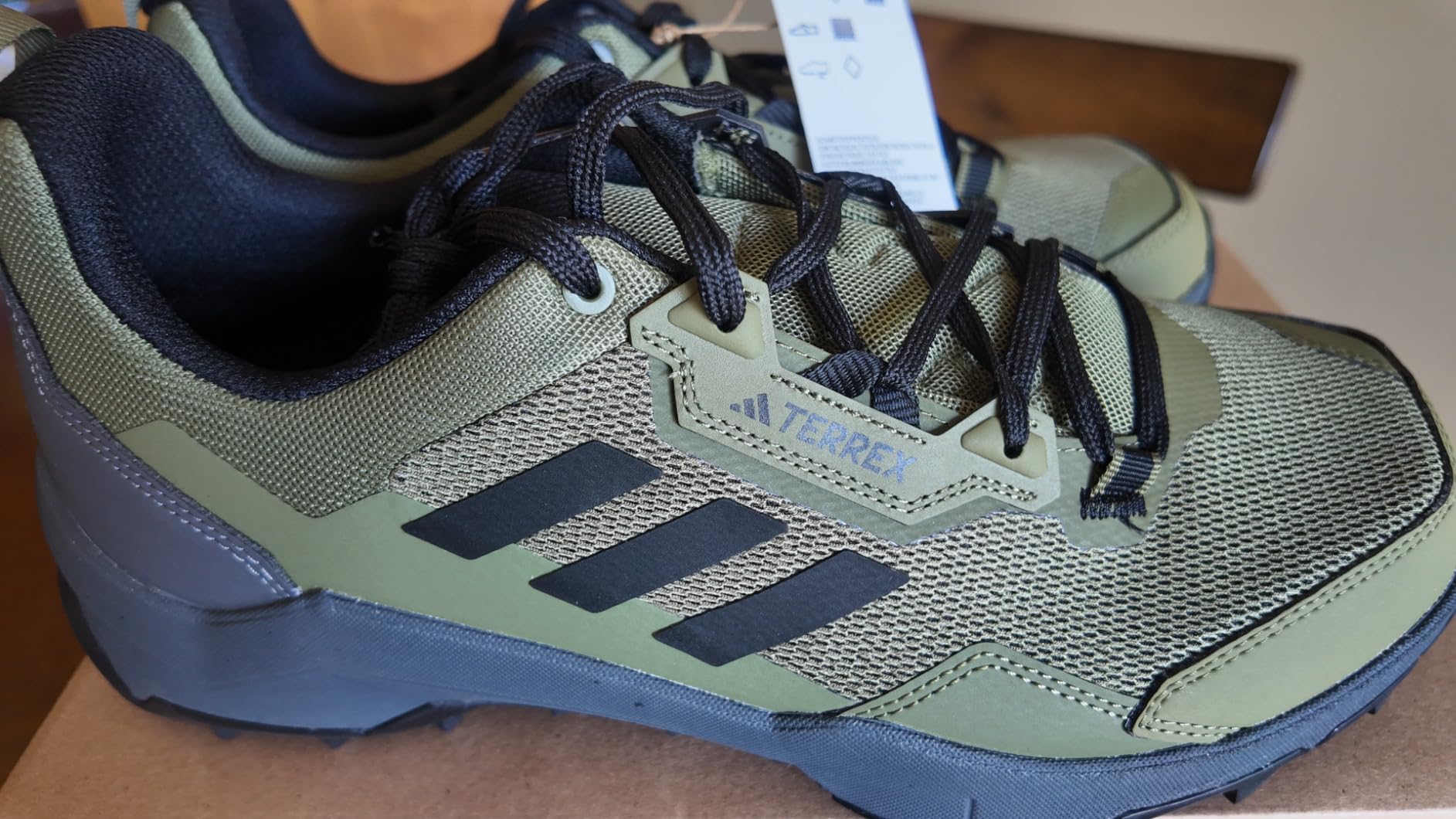
Who Should Buy the Adidas Terrex AX4?
Perfect for:
- Day hikers wanting lightweight, breathable footwear
- Trail-to-street versatility seekers
- Budget-conscious hikers seeking good traction
- Warm weather hiking in dry conditions
- Those who appreciate Continental rubber performance
Not ideal for:
- Wide-footed hikers (unless sizing up significantly)
- Wet weather hiking without Gore-Tex version
- Heavy backpacking or technical terrain
- Those needing maximum cushioning
- True-to-size fit expectations
Better Options for Specific Needs
For wide feet: Consider Merrell Moab 3 or New Balance Fresh Foam X Hierro
For waterproofing: Look for the Gore-Tex version or Salomon X Ultra 3 GTX
For maximum cushioning: Hoka Speedgoat or Altra Lone Peak
For true-to-size fit: Most Salomon or Merrell options
Final Recommendation
The Adidas Terrex AX4 earns a solid recommendation with the important caveat about sizing. If you can accept sizing up and don’t need waterproofing, these deliver excellent value with standout traction performance. The Continental rubber alone makes them worth considering for day hiking applications.
Get the best price on Amazon:
Frequently Asked Questions
Do these run true to size?
No – this is the most consistent complaint. Most reviewers recommend sizing up 0.5-1 full sizes. I normally wear size 10 and needed 10.5 for proper fit. If you have wide feet, consider going up a full size.
Are these waterproof?
The standard AX4 is NOT waterproof. Adidas makes Gore-Tex versions, but many listings incorrectly show Gore-Tex labeling for non-waterproof versions. Check carefully that the shoe actually has Gore-Tex tags if waterproofing is important.
How’s the durability for daily wear?
Mixed results. Some users report 2-3 years of regular hiking use, while others experienced faster wear with daily urban walking. The Continental rubber outsole is quite durable, but the mesh upper may wear faster with heavy daily use.
What about the white specks on the sole?
Multiple reviewers reported white specks on the rubber sole that don’t wipe off. This appears to be a manufacturing/quality control issue. Functionally it doesn’t affect performance, but it’s cosmetically annoying.
How do they compare to Merrell Moabs?
The Terrex AX4 is lighter and more breathable than Moab 3, with better traction from the Continental rubber. However, Moabs fit more consistently and offer better toe box room for wide feet.
Can I use these for trail running?
They’re borderline. The 13.2 oz weight is heavier than most trail runners, but the low-cut design and good traction make them viable for slower trail running. Dedicated trail runners would be better for serious running.
What’s the break-in period like?
Relatively quick – most users report 1-3 days of wear for break-in. The mesh upper is flexible, so there’s less stiffness to work through compared to leather hiking boots.
Are they good for disc golf?
Several reviewers mentioned using them for disc golf with good results. The Continental rubber provides good grip for pivoting, and they’re comfortable for walking courses. However, some reported faster wear with the specific stresses of disc golf.
Review Scoring Summary
| Category | Score | Weight | Weighted Score |
|---|---|---|---|
| Traction & Grip | 8.5/10 | 25% | 2.13 |
| Comfort & Fit | 7.0/10 | 20% | 1.40 |
| Durability | 7.5/10 | 20% | 1.50 |
| Breathability | 9.0/10 | 15% | 1.35 |
| Weight | 8.5/10 | 10% | 0.85 |
| Value for Money | 8.0/10 | 10% | 0.80 |
| Final Weighted Score | 7.8/10 | 100% | 8.03 |

